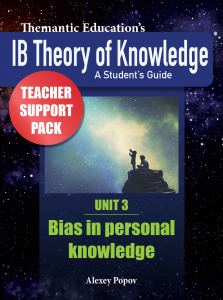This is the fifth in a series of blog posts entitled “Traps and loopholes in the new TOK syllabus”. You can access the full list of blog posts in the series here.
As you know, in the new TOK syllabus the old presentation was replaced by the TOK exhibition for the Internal Assessment (IA). Students need to display three real-world objects and write a commentary for each of them explaining how this objects links to one of the 35 knowledge questions (the IA prompts). The task seems to be easier than the old presentation, and it makes sense to get it done in the first year of the IB DP programme.
Most people who follow the linear approach would do the themes first, followed by areas of knowledge.

Beware the trap of following the guide in a linear way.
However, as I wrote in my previous blog post (see “Themes as a trap: TOK essay is based on areas of knowledge”), I really want to start with the areas of knowledge as soon as possible. Kids needs them for the essay, and the essay is twice as important as the exhibition in terms of marks. Ideally, I would like to start with areas of knowledge straight away, and teach them all in comparison.
But then again, there is this mysterious line in the Guide that can cause doubts: the IB “strongly recommends” to base the TOK presentation on one of the themes (either the core theme or one of the optional themes). I think it’s a potential trap because some teachers may misinterpret this recommendation as a requirement to teach linearly (first themes, then areas of knowledge).
Here is what we need to understand:
- The link to the theme in the TOK exhibition is neither assessed, nor marked, nor required. There are three things that are required in the exhibition commentary: (a) explain how the object links to the IA prompt, (b) explain the real-world context of the object, (c) justify the inclusion of the object in the exhibition. Linking the object to one of the themes is not required, neither is it recommended because you will end up wasting valuable word count (950 words) for no reason.
- This means, really, that objects for the TOK exhibition can come from anywhere. They don’t have to be linked to one of the IB themes. They can be linked to an area of knowledge, for example.
- So why this “strong recommendation” of the IB? The rationale behind it is simply to make the choice process easier for the kids. If you give them the whole world to choose from, they will struggle. If you narrow down the choice for them, they will do better. The IB tested the syllabus in several schools before they rolled it out, and that’s exactly what they observed. Hence their “strong recommendation”.
But the thing is, limiting students to one of the IB themes is not the only way to narrow down the choice for them! You can narrow them down to one concept. You can narrow them down to one area of knowledge. You can narrow them down to several topics that you’ve studied.
So… does the TOK exhibition have to be based on one of the themes? My answer is no.
My solution is to teach areas of knowledge through the themes. Start themes and areas of knowledge at the same time. By doing so, I will give students a head start in the preparation for the TOK essay. But I will also narrow them down to one particular theme or a set of concepts when it comes to choosing the objects for their TOK exhibition. It may be the concept of “bias”, for example. This list of lessons in our Student’s Guide has plenty to choose from.
See more in this blog post: “Themes as an opportunity: Teach areas of knowledge through themes and kill multiple birds with one stone” (coming soon)

Alexey Popov is a teacher of IB Psychology and Theory of Knowledge. He is an IB author, examiner and workshop leader. He also authored Oxford IB Psychology books. He currently lives in Hong Kong.

